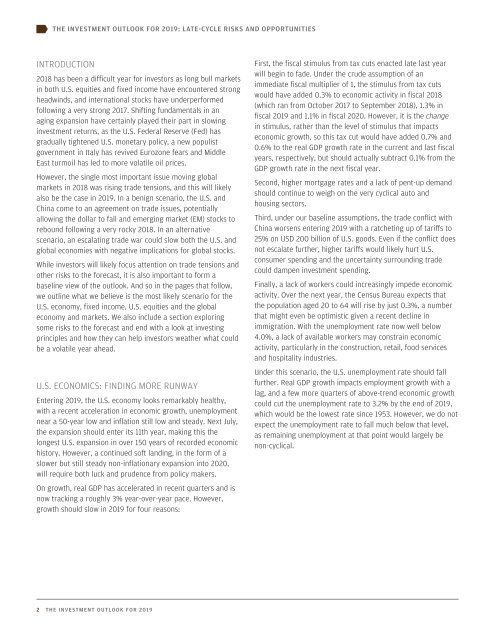You also want an ePaper? Increase the reach of your titles
YUMPU automatically turns print PDFs into web optimized ePapers that Google loves.
THE INVESTMENT OUTLOOK FOR 2019: LATE-CYCLE RISKS AND OPPORTUNITIES<br />
INTRODUCTION<br />
2018 has been a difficult year for investors as long bull markets<br />
in both U.S. equities and fixed income have encountered strong<br />
headwinds, and international stocks have underperformed<br />
following a very strong 2017. Shifting fundamentals in an<br />
aging expansion have certainly played their part in slowing<br />
investment returns, as the U.S. Federal Reserve (Fed) has<br />
gradually tightened U.S. monetary policy, a new populist<br />
government in Italy has revived Eurozone fears and Middle<br />
East turmoil has led to more volatile oil prices.<br />
However, the single most important issue moving global<br />
markets in 2018 was rising trade tensions, and this will likely<br />
also be the case in 2019. In a benign scenario, the U.S. and<br />
China come to an agreement on trade issues, potentially<br />
allowing the dollar to fall and emerging market (EM) stocks to<br />
rebound following a very rocky 2018. In an alternative<br />
scenario, an escalating trade war could slow both the U.S. and<br />
global economies with negative implications for global stocks.<br />
While investors will likely focus attention on trade tensions and<br />
other risks to the forecast, it is also important to form a<br />
baseline view of the outlook. And so in the pages that follow,<br />
we outline what we believe is the most likely scenario for the<br />
U.S. economy, fixed income, U.S. equities and the global<br />
economy and markets. We also include a section exploring<br />
some risks to the forecast and end with a look at investing<br />
principles and how they can help investors weather what could<br />
be a volatile year ahead.<br />
U.S. ECONOMICS: FINDING MORE RUNWAY<br />
Entering 2019, the U.S. economy looks remarkably healthy,<br />
with a recent acceleration in economic growth, unemployment<br />
near a 50-year low and inflation still low and steady. Next July,<br />
the expansion should enter its 11th year, making this the<br />
longest U.S. expansion in over 150 years of recorded economic<br />
history. However, a continued soft landing, in the form of a<br />
slower but still steady non-inflationary expansion into 2020,<br />
will require both luck and prudence from policy makers.<br />
On growth, real GDP has accelerated in recent quarters and is<br />
now tracking a roughly 3% year-over-year pace. However,<br />
growth should slow in 2019 for four reasons:<br />
First, the fiscal stimulus from tax cuts enacted late last year<br />
will begin to fade. Under the crude assumption of an<br />
immediate fiscal multiplier of 1, the stimulus from tax cuts<br />
would have added 0.3% to economic activity in fiscal 2018<br />
(which ran from October 2017 to September 2018), 1.3% in<br />
fiscal 2019 and 1.1% in fiscal 2020. However, it is the change<br />
in stimulus, rather than the level of stimulus that impacts<br />
economic growth, so this tax cut would have added 0.7% and<br />
0.6% to the real GDP growth rate in the current and last fiscal<br />
years, respectively, but should actually subtract 0.1% from the<br />
GDP growth rate in the next fiscal year.<br />
Second, higher mortgage rates and a lack of pent-up demand<br />
should continue to weigh on the very cyclical auto and<br />
housing sectors.<br />
Third, under our baseline assumptions, the trade conflict with<br />
China worsens entering 2019 with a ratcheting up of tariffs to<br />
25% on USD 200 billion of U.S. goods. Even if the conflict does<br />
not escalate further, higher tariffs would likely hurt U.S.<br />
consumer spending and the uncertainty surrounding trade<br />
could dampen investment spending.<br />
Finally, a lack of workers could increasingly impede economic<br />
activity. Over the next year, the Census Bureau expects that<br />
the population aged 20 to 64 will rise by just 0.3%, a number<br />
that might even be optimistic given a recent decline in<br />
immigration. With the unemployment rate now well below<br />
4.0%, a lack of available workers may constrain economic<br />
activity, particularly in the construction, retail, food services<br />
and hospitality industries.<br />
Under this scenario, the U.S. unemployment rate should fall<br />
further. Real GDP growth impacts employment growth with a<br />
lag, and a few more quarters of above-trend economic growth<br />
could cut the unemployment rate to 3.2% by the end of 2019,<br />
which would be the lowest rate since 1953. However, we do not<br />
expect the unemployment rate to fall much below that level,<br />
as remaining unemployment at that point would largely be<br />
non-cyclical.<br />
2 THE INVESTMENT OUTLOOK FOR 2019
















